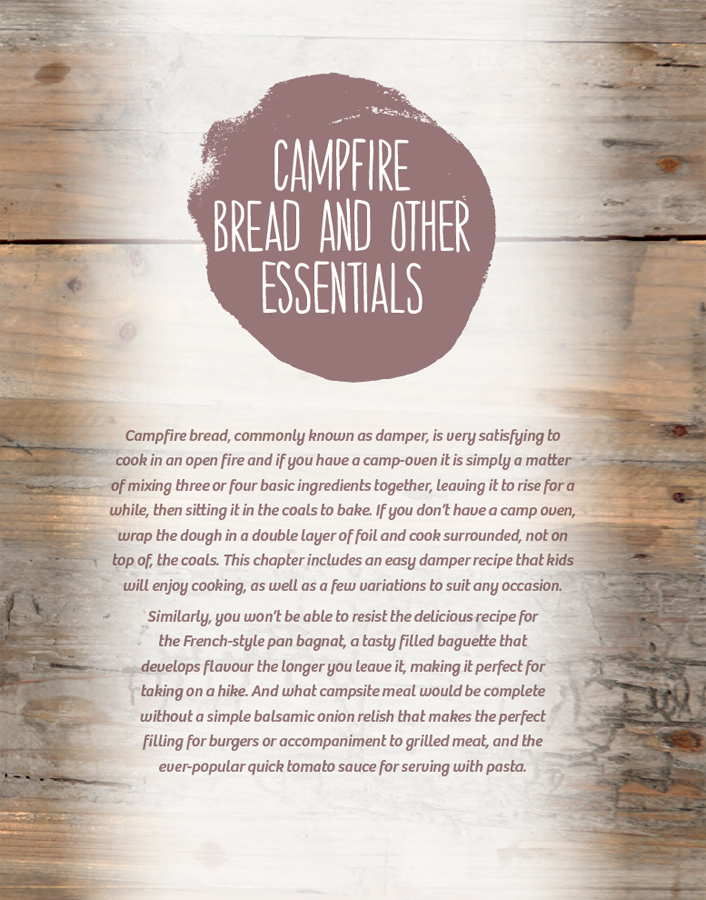

KIDS’ EASY CAMPFIRE BREAD DAMPER
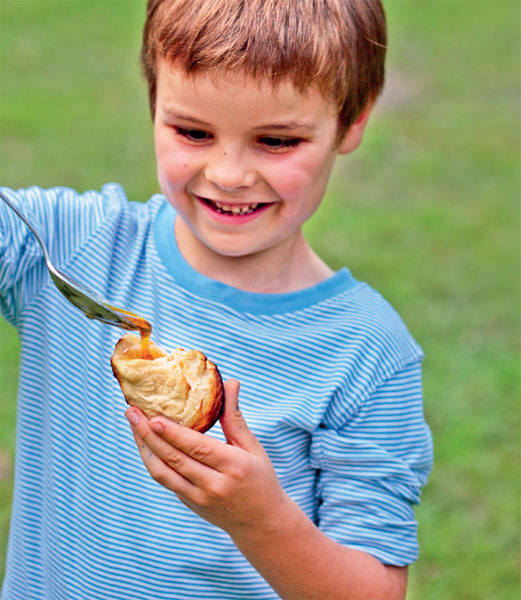
Damper is a tried and true campfire bread that pretty much everyone adores. I like to add butter and sugar, which a traditional damper would not usually include. Let the kids make the dough and divide it into portions, then wrap each portion around the top part of a long stick. The kids can then cook it over the fire. Once cooked, fill the hole where the stick was with honey, jam or nutella. Be warned – once you have made this the first time, your kids will invariably start asking you to make more!
MAKES 6 small breads
300 g (2 cups) self-raising flour, plus extra as needed
½ teaspoon salt
2 teaspoons sugar
2 tablespoons butter
250–310 ml (1–1¼ cups) milk
honey, jam or nutella, to serve

1 Combine the flour, salt and sugar in a large bowl. Add the butter and use your fingertips to rub it into the flour until it is all incorporated – it should resemble breadcrumbs.
2 Gradually add the milk and knead to combine, adding just enough to make a dough that isn’t too sticky and that can be easily kneaded. If it’s too sticky or wet, it will drop off the sticks when it is being cooked. Add a little extra flour if this is the case. Knead in the bowl for about 10 minutes, or until soft and elastic, giving everyone a turn so they all get to join in the fun.
3 Divide the damper into six portions, form into balls and shape into ovals around the top of six long, thick sticks. With parental supervision, let the kids cook the bread over the fire for about 10–15 minutes, turning the bread regularly, until golden brown on all sides. When the bread is cooked, it will sound hollow when tapped. Wait for 5 minutes (if the kids are patient enough), then remove from the stick and fill with your favourite filling.

CHEESE AND HERB CAMPFIRE BREAD DAMPER
For this bread to work, it’s important the beer is at room temperature before you start. If your beer is chilled, pour into a small saucepan and heat gently over the fire or a gas cooker. Don’t worry too much if you can’t measure things out properly – it is a pretty forgiving recipe.
MAKES 1 loaf
450 g (3 cups) self-raising flour, plus about
2–3 tablespoons extra
1 teaspoon salt
250 ml (1 cup) beer, at room temperature
2 tablespoons olive oil
75 g (¾ cup) grated cheddar or parmesan cheese
3 tablespoons chopped fresh herbs, such as parsley, chives or tarragon, or use 3 teaspoons dried herbs
1 Combine all of the ingredients in a large bowl (preferably a metal one as it will need to sit by the heat at one point) and use your hands to bring the mixture together. If it’s sticky, add a little extra flour. Knead in the bowl for about 10 minutes, or until soft and elastic.
2 Cover the dough with a clean tea towel and place close to the fire (but not on it) or in a warm place for 30 minutes, until the dough has risen in size. At the same time, place your camp oven close to the fire to warm through, but don’t let it get too hot.
3 Very lightly dust the base of the camp oven with a little extra flour. Transfer the dough to the camp oven, sprinkle lightly with flour, then cover and sit close to the fire surrounded by coals. Don’t sit it on top of the coals or the damper will burn. If cooking over a fire pit with a grill tray that swings around, put the camp oven on this and put some coals on top of the camp oven too, to ensure an all-round heat.
4 Cook for 30–40 minutes, checking the coals every now and then, adding more as necessary, until the damper is cooked and it sounds hollow when tapped. If your damper is taking longer to cook, just keep replacing the coals. Remove from the camp oven, leave for 5 minutes, then serve in chunks or slices.

BEER AND PESTO CAMPFIRE BREAD DAMPER
It’s amazing what you can create with so few ingredients. This is such a simple recipe and the addition of beer and pesto raise it from a plain old damper to one that is far more flavourful and interesting. Like all damper, it is delicious for dipping into the juices of casseroles and stews.
MAKES 1 loaf
450 g (3 cups) self-raising flour, plus about 2–3 tablespoons extra
1 teaspoon salt
250 ml (1 cup) beer, at room temperature
2 tablespoons olive oil
60 g (¼ cup) pesto
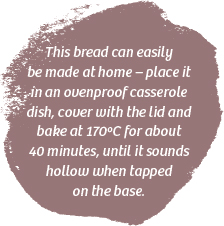
1 Combine all of the ingredients in a large bowl (preferably a metal one as it will need to sit by the heat at one point) and use your hands to bring the mixture together. If it’s sticky, add a little extra flour. Knead in the bowl for about 10 minutes, or until soft and elastic.
2 Cover the dough with a clean tea towel and place close to the fire (but not on it) or in a warm place for 30 minutes, until the dough has risen in size. At the same time, place your camp oven close to the fire to warm through, but don’t let it get too hot.
3 Very lightly dust the base of the camp oven with a little extra flour. Transfer the dough to the camp oven, sprinkle lightly with flour, then cover and sit close to the fire surrounded by coals. Don’t sit it on top of the coals or the damper will burn. If cooking over a fire pit with a grill tray that swings around, put the camp oven on this and put some coals on top of the camp oven too, to ensure an all-round heat.
4 Cook for 30–40 minutes, checking the coals every now and then, adding more as necessary, until the damper is cooked and it sounds hollow when tapped. If your damper is taking longer to cook, just keep replacing the coals. Remove from the camp oven, leave for 5 minutes, then serve in chunks or slices.

SUNDRIED TOMATO AND OLIVE CAMPFIRE BREAD DAMPER
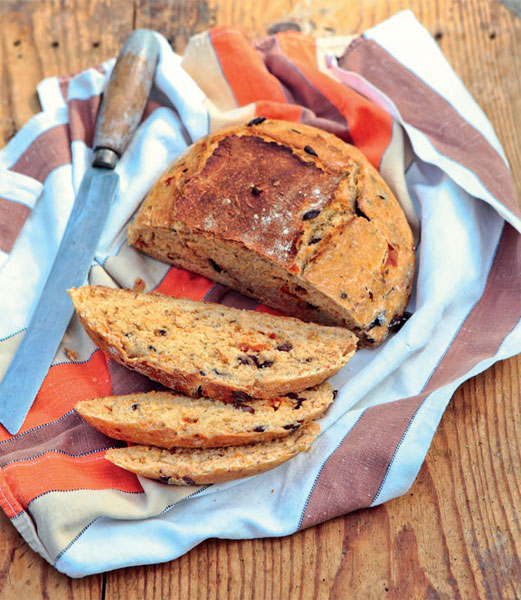
Of all the dampers I make, this is probably my favourite. When friends try this they are amazed that it is so easy to prepare. If you have the time, this recipe is definitely worth trying!
MAKES 1 loaf
450 g (3 cups) self-raising flour
1 teaspoon salt
2 tablespoons olive oil
75 g (½ cup) chopped sun-dried tomatoes
20–25 pitted kalamata olives, roughly chopped
250 ml (1 cup) beer, at room temperature
1 Put all the ingredients, except the beer, into a large bowl, preferably a metal one as it will need to sit by the heat at one point. Add about three-quarters of the beer and use your hands to bring the mixture together. If the dough seems too dry add a bit more beer, but don’t add too much that the dough is sticky and difficult to handle. Knead in the bowl for about 10 minutes, or until soft and elastic.
2 Cover the dough with a clean tea towel and place close to the fire (but not on it) or in a warm place for 30 minutes, until the dough has risen in size. At the same time, place your camp oven close to the fire to warm through, but don’t let it get too hot.
3 Transfer the dough to the camp oven, cover, and sit it close to the fire so it is surrounded by coals – you can put some coals on the lid as well. It’s very important not to sit the camp oven on top of the coals as the bottom will burn. If cooking over a fire pit with a grill tray that swings round, put the camp oven on this and carefully put some coals on top of the camp oven too, to ensure an all-round heat.
4 Cook for 30–40 minutes, checking the coals every now and then, adding more as necessary, until the damper is cooked and it sounds hollow when tapped. If your damper is taking longer to cook, don’t worry, just ensure you keep replacing the coals. Carefully remove from the camp oven, leave for 5 minutes, then serve in chunks or slices.

PAN BAGNAT
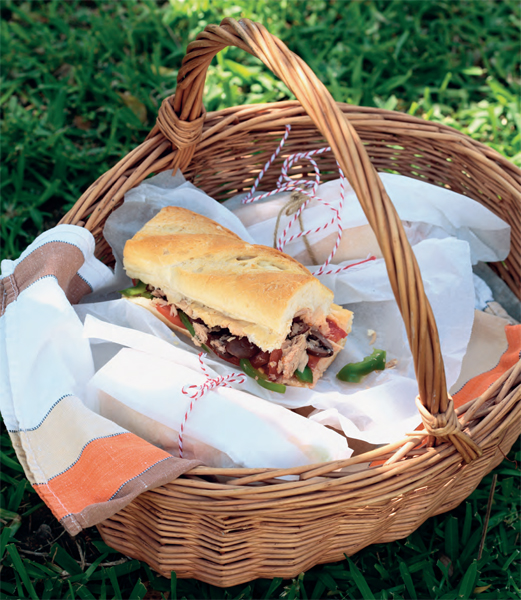
Pan bagnat is a traditional French recipe and is literally a baguette soaked lightly in olive oil and filled with delicious ingredients. The traditional recipe uses tuna as part of the filling, but you could replace it with chicken if preferred.
MAKES 1 long baguette
1 long bread stick
1 garlic clove, halved
60–80 ml (¼–½ cup) olive oil
3 firm, ripe tomatoes, sliced
1 small green capsicum (pepper), seeded and thinly sliced
15 pitted kalamata olives, halved
185 g tin tuna in spring water, drained

1 Cut the bread stick in half horizontally and remove a little of the dough to form a hollow.
2 Rub the bread all over with the garlic halves, then liberally drizzle the olive oil all over the bread.
3 Layer the tomato, capsicum, olives and tuna on one side of the baguette and season with salt and freshly ground black pepper. Top with the other baguette half.
4 Cut the filled baguette into four shorter lengths and wrap individually in foil or greaseproof paper. Leave for at least an hour to allow the flavours to mingle and the oil to soak into the bread before serving.

BALSAMIC ONION RELISH
This tasty onion relish works well served as an accompaniment to chargrilled steak and chicken, or is equally at home on cheese or chicken sandwiches. It is especially yummy with the pesto lamb burgers.
SERVES 4–6
2 large onions, halved and thinly sliced
1 tablespoon olive oil
1 tablespoon balsamic vinegar
2 teaspoons sugar
1 Put the onion in a bowl, add the oil and toss to coat. Place onto a hot barbecue flatplate or in a frying pan over the fire or a gas cooker and cook for about 10 minutes, stirring regularly so they soften and turn golden brown but don’t burn.
2 Scoop the onion into a pile, pour over the vinegar and sprinkle over the sugar. Mix together using a fork or tongs and cook for a further 2 minutes. Balsamic onion relish can be served warm or cool. Any leftovers can be covered and stored in the cool box for up to two days.

QUICK TOMATO SAUCE FOR PASTA
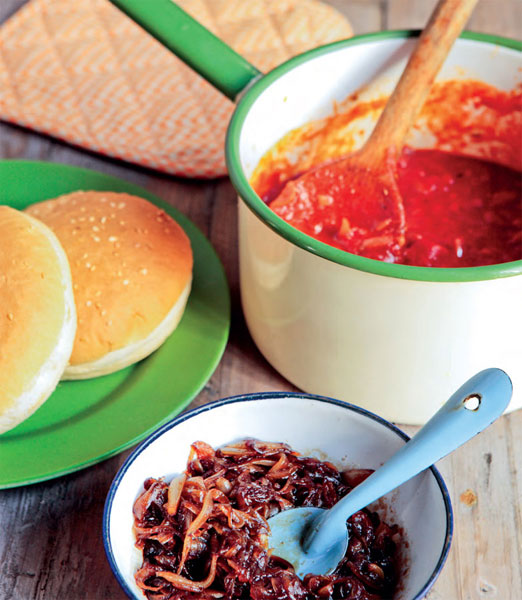
This is a useful sauce to prepare when you either don’t have much time, or everything else has already been eaten. You can add chopped kalamata olives and fresh basil leaves or add some diced capsicum (pepper) and zucchini (courgette) for a vegetable fix.
SERVES 4
1 tablespoon olive oil
1 large onion, halved and thinly sliced
2 garlic cloves, crushed
2 x 400 g tins chopped tomatoes
2 teaspoons dried oregano
2 teaspoons sugar
pasta, to serve
grated cheese, to serve

1 Heat the olive oil in a heavy-based saucepan or large frying pan. Add the onion and garlic and cook for about 5 minutes over a gentle heat on a gas cooker or over a low fire.
2 Add the tomatoes, oregano and sugar and season well with salt and freshly ground black pepper. Cover and simmer for 10 minutes.
3 Cook the pasta according to the packet instructions, serve with the sauce spooned over the top and sprinkle over some grated cheese.